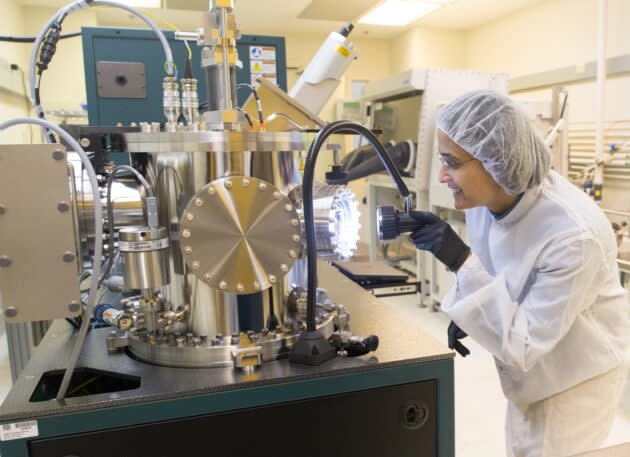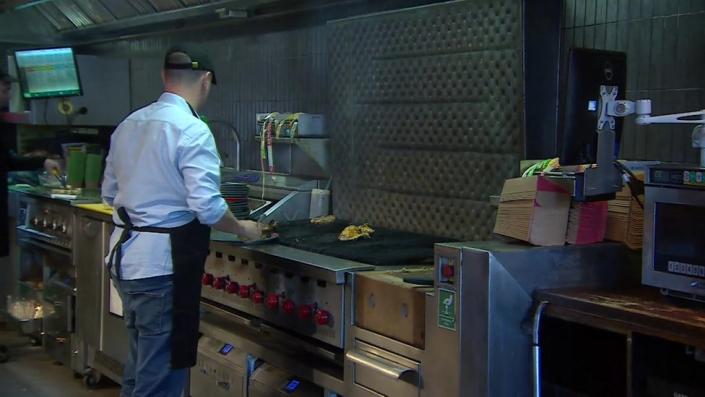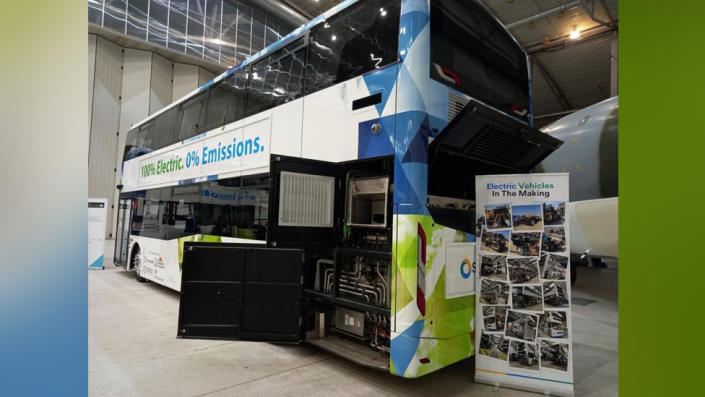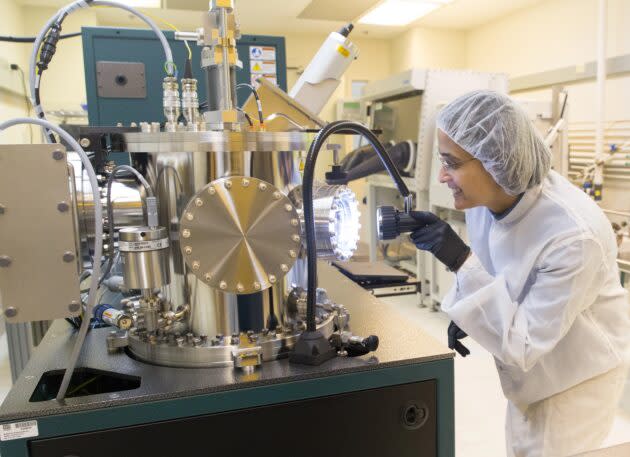Science Daily News | 13 May 2023

Views (204)

Nando's recycles kitchen heat to warm water
A system devised by a Lancashire firm enables a restaurant chain to use kitchen heat to warm water.

A restaurant chain is using waste heat generated from its kitchen to heat water and buildings following trials.
The success of the year-long trial at Nando's Didsbury branch in Manchester has been rolled out to 14 other stores.
The system created by Lancashire energy firm Dext Heat Recovery uses a heat exchange - a box on the roof which collects the heat produced by cooking.
Instead of releasing it into the atmosphere, the heat is filtered and recycled.
Prof Karl Williams, director of the centre for waste and resource management at the University of Central Lancashire, said he was excited about ways to recover energy to combat the climate emergency.
"There's lots of technology out there to recover energy for example from sewers, but every bit helps to reduce our reliance on fossil fuels," he said.
Prof Williams added: "The main challenge I see with this is cost, to have a real impact it needs to go into smaller businesses on our high streets because there are a lot more of them than big chains.
"They'd find it difficult to invest as it would take them longer to get payback as they don't generate as much heat as larger chains."
The amount of heat produced in the average Nando's kitchen a year is enough to heat more than 30 homes for a year.
Dext has been working with Nando's since 2009 when they started collecting the heat from its grills to heat water- a system which is now used to save energy in 300 branches.
Director of Dext Heat Recovery Neil Bracewell said he believed it could be a game changer for the restaurant industry.
"We work with Sheffield Hallam University where we developed and researched the heat exchanger to cope with dirty air from restaurant kitchens.
"Nando's have helped us financially and by allowing us to test our equipment."
He added it was still a "learning curve", but they were "saving money and reducing CO2 emissions".
Mr Bracewell said their systems currently start at about £20,000 but estimated the outlay could be made back in 18 months depending on the size and use of the kitchen.
Sam McCarthy, Nando's head of sustainability for the UK and Ireland, said they were keen to share this technology with other restaurant chains.
"We have a net zero target of 2030 and this new technology is proving to be a success reducing the impact on the planet and saving money on energy bills which we want to reinvest in the future of our restaurants.
"We're always looking to trial new technology to help us with this and it's great to support and work with a small business like Dext."
More than 25% of biodiversity is under our feet — but we're destroying it. A biotech startup that's raised $56 million has a plan to help save our soil.
Humans rely on healthy soils for 95% of our food. The women-led startup Trace Genomics uses DNA data to help farmers protect soil biodiversity.

Soil biodiversity enables farming, purifies water, sequesters carbon, and more.
The women-led biotech startup Trace Genomics is working to reverse human-caused soil erosion.
You might flinch at the thought of billions of bacteria, fungi, and critters at work under our feet, but dirt is home to a living network that can protect crops and humans from disease, purify and conserve water, break down pollutants, and remove carbon dioxide from the atmosphere.
But we can't see it, we don't know a lot about it — and we're destroying it.
In response to this challenge, Trace specializes in metagenomics, which uses similar technology as a doctor might use to test a patient's stomach microbiome. But instead of sampling the microbes managing our gut health, it aims to sequence the DNA of all the microbes in a soil sample.
Trace Genomics' president, Poornima Parameswaran, has been working with DNA sequencing for nearly two decades. She realized she could use it to fill an information gap in soil health and sustainable agriculture.
"Unless and until you know what's in the soil, how do you know what opportunities exist and how to create products that really foster biodiversity and other soil functions?" Parameswaran said.
Trace has one of the largest agricultural-soil databases in the world. One feature allows Trace to give farmers a score based on the presence of biodiversity, water, nutrients, and carbon in the soil. Based on that score, investors can better judge the soil sustainability of the product grown there.
Trace also uses its data to provide analytics that farmers can use directly. For example, Trace can analyze soil functions like nutrient cycling — even if it doesn't know the name of the microorganisms doing the job.
The opportunity to help fight crop diseases led Parameswaran and Diane Wu, her cofounder, to start Trace Genomics in 2015. Both researchers at Stanford at the time, they began walking fields with local berry and lettuce growers. They learned that as bans on chemicals came rolling in, the farmers struggled to find alternatives to effectively treat their fields.
The two researchers first built a lab to diagnose diseases in berries and lettuce. Seven years later, Trace's system can give disease reports for more than 70 different crops.
Mike Toelle grows soybeans, corn, and alfalfa on his family-owned farm on the border of Minnesota and South Dakota. For the past five years, he's been helping Trace gather data as part of its pilot program.
In that time, Trace's challenge has been to zero in on meaningful diagnostics for farmers.
"Initially, it was almost overwhelming because there's so much information," Toelle said.
Trace's clients, including Toelle, transfer about three samples of the soil from each of their fields into small coffee bags, mark them with a GPS location, and mail them to Trace's lab in Ames, Iowa.
From there, Trace's scientists extract the DNA from the soil and run it through a sequencing machine — a nearly 200-pound device that looks like a tabletop office printer.
After the sequencer runs for 25 to 30 hours, they've generated up to five gigabytes of data that they analyze, upload to their digital platform, and share with the farmer in various forms, such as color-coded maps.
Farmers have historically had access to chemical tests for their soils, which can give information such as the presence of nutrients or a field's acidity. Some companies offer DNA sequencing to test fields for specific diseases. But Trace is one of few companies to analyze the entirety of a field's biology: the billions of microscopic citizens that live in every tablespoon of soil.
Trace's data about the living residents in soil allows it to tell farmers new information about their soil health, such as how well their fields can hold on to crucial nutrients including nitrogen and phosphorus.
Toelle told Insider that Trace's nutrient and disease data had helped him decide how much fertilizer to spread and which crop varieties to plant, as well as where to put them on his fields.
"Every soil is different," Toelle said. "Even within a field, your soils are different, so we really need to understand and get very precise about what we're doing even within a field boundary."
Jason Stegink, an agronomist who serves as a consultant for farmers in western Michigan, is working toward having more than half of his clients use Trace's service.
On one field, a test from Trace confirmed an insight that took him two years to notice without it.
While a traditional chemical test had told him there were plenty of nutrients on the field, he realized his crop was growing unevenly. He needed to add more fertilizer because low microbiological health was preventing the nutrients from being shared throughout the soil.
"The Trace data told us that in one shot," Stegink said.
But Trace's precision comes at a tenfold price. Where a chemical test might run him $20, Trace's test could run him $200.
As farmers try to both increase production and decrease waste, soil insights like those from Trace could help them decide which crops, fertilizers, and chemicals to spread and where.
An aerial view shows a variety of farmland in North Dakota.Trace Genomics
And to move away from fertilizers, which are finite resources and require massive mining and transportation chains, the agriculture industry can use information from Trace to test eco-friendly alternatives like biologicals. These organic products include microorganisms, insects, and plant extracts that could replace the need for generic fertilizers by regenerating the living network in soil.
"Trace is one of the pieces that might be able to help not only verify some of those products in their efficacy but also target our integration of some of those products," Stegink said.
Toelle and Stegink agreed that Trace's price and precision would improve over time.
Just as technologies such as microbiome sequencing and probiotics are innovating the way patients are experiencing doctor visits, companies like Trace are working to bring the same tech to soil treatment.
"If we can prescriptively treat things going forward, everything is better," Stegink said. "Our performance is better in the field. Our cost is better. Our environmental impact is better."
Early heat wave in Pacific Northwest could break records
An early May heat wave this weekend could surpass daily records in parts of the Pacific Northwest and worsen wildfires already burning in western Canada, a historically temperate region that has grappled with scorching summer temperatures and unprecedented wildfires fueled by climate change in recent years. “We’re looking at record-breaking temperatures,” said Miles Higa, meteorologist at the National Weather Service’s Portland office, describing the warmth as “unusual for this time of year.”

“We’re looking at record-breaking temperatures,” said Miles Higa, meteorologist at the National Weather Service’s Portland office, describing the warmth as “unusual for this time of year.”
The National Weather Service issued a heat advisory Friday lasting from Saturday through Monday for much of the western parts of both Oregon and Washington state. It said the temperatures could raise the risk of heat-related illness, particularly for those who are dehydrated or don't have effective cooling.
Temperatures in Portland, Oregon, are expected to hover around 94 F (34.4 C) throughout the weekend, according to the website of the National Weather Service office there. The current daily temperature records for May 13 and 14 stand at 92 F (33.3 C) and 91 F (32.8 C), dating from 1973 and 2014, respectively.
Elizabeth Romero and her three children were among those cooling off at a fountain in downtown Portland on Friday afternoon.
“We decided to stop by ... until we all feel better," she said, adding that she plans to seek out shaded parks during the weekend.
Temperatures in the Seattle area could also meet or surpass daily records, according to National Weather Service meteorologist Jacob DeFlitch. The mercury could near 85 F (29.4 C) on Saturday and reach into the low 90s (32.2 C) on Sunday, he said.
King County, home to Seattle, directed transportation operators such as bus drivers to let people ride for free if they're seeking respite from the heat or heading to a cooling center. The county's regional homeless authority said several cooling and day centers will be open across the county.
Authorities also urged people to be wary of cold water temperatures, should they be tempted to take a river or lake swim to cool off.
“Rivers are still running cold. We have snow melting and temperatures … probably in the low- to mid-40s (4.4 to 7.2 C) right now,” National Weather Service meteorologist Higa said. “You’re nice and warm and jump into the cold water — that could pose a risk to getting cold water shock.”
In response, Oregon passed a law requiring all new housing built after April 2024 to have air conditioning installed in at least one room. The law already prohibits landlords in most cases from restricting tenants from installing cooling devices in their rental units.
Last summer, Portland launched a heat response program with the goal of installing portable heat pump and cooling units in low-income households, prioritizing residents who are older and live alone, as well as those with underlying health conditions. Local nonprofits participating in the program installed more than 3,000 units last year, according to the city's Bureau of Planning and Sustainability.
One of those nonprofits, Verde, said interest in the units has been high. Verde has installed roughly 180 units so far this year, and their waitlist last year was nearly 500 people long, said Ricardo Moreno, a project manager for the group who oversees its heat response program.
“People we’ve talked to, mostly elderly people with some health conditions, they all shared that having these units have made a world of difference and definitely improved the quality of their lives through the summer,” Moreno said.
Another local nonprofit, the African American Alliance for Homeownership, installed 1,200 units last year and 75 units so far this year, program manager Richard Hines-Norwood said.
Officials in Multnomah County, home to Portland, said they weren’t planning on opening special cooling centers for now but are monitoring the forecast and can do so if needed.
“This is the first significant event … and it is early for us,” said Chris Voss, the county’s director of emergency management. “We’re not seeing a situation where we are hearing that this is extremely dangerous. That being said, we don’t know if it’s going to drift.”
Outreach teams have started visiting homeless encampments to let them know about the resources available to them, Voss said. Air-conditioned libraries are an example of a public place where people can cool off, he added.
___
Associated Press writer Ed Komenda contributed from Seattle.
___
Claire Rush is a corps member for the Associated Press/Report for America Statehouse News Initiative. Report for America is a nonprofit national service program that places journalists in local newsrooms to report on undercovered issues.
Astronomers detect largest cosmic explosion ever seen
Astronomers have discovered what they believe to be the largest explosion ever detected.

Astronomers have discovered what they believe to be the largest explosion ever detected.
The explosion is more than 10 times brighter than any recorded exploding star - known as a supernova.
So far it has lasted more than three years, much longer than most supernovae which are usually only visibly bright for a few months.
One theory is that the blast was caused when a vast cloud of gas was swallowed up by a black hole.
A flash in the sky was first automatically detected and recorded in 2020 by the Zwicky Transient Facility in California. But it wasn't until a year later that it was picked up by astronomers combing through the data.
They called the event AT2021lwx. At the time they thought it was unremarkable because there was no indication of how far away it was and therefore it wasn't possible to calculate its brightness.
Last year a team led by Dr Philip Wiseman from the University of Southampton analysed the light from the event which enabled them to calculate its distance - 8bn light years away. Dr Wiseman described the moment the worked out the brightness of the phenomenon.
"We thought 'oh my God, this is outrageous!'".
The team were completely baffled as to what could have caused something so bright. There was nothing in the scientific literature that could account for something that was so bright that lasted so long, according to Dr Wiseman.
"Most supernovae and tidal disruption events only last for a couple of months before fading away. For something to be bright for two plus years was immediately very unusual."
His theory is that the explosion is a result of an enormous cloud of gas, possibly thousands of times larger than our Sun, swallowed up by a supermassive black hole.
This would send shockwaves across space and leave superheated remnants of the cloud surrounding the black hole like a giant ring doughnut.
All galaxies are thought to have giant black holes at their heart. Dr Wiseman believes that such powerful explosions could play an important role in what he describes as "sculpting" the centre of galaxies.
"It could be that these events, although extremely rare, are so energetic that they are key processes to how the centres of galaxies change over time".
The search is now on for more huge explosions like this, according to Dr Robert Massey who is the Deputy Executive Director of the Royal Astronomical Society.
"We've never seen anything like this before and certainly not on this scale," he told BBC News.
"I'd be amazed if this is the only object like this in the Universe".
Dr Wiseman hopes to detect more events like this with new telescope systems coming online in the next few years.
The team are now setting out to collect more data on the explosion - observing the object in different wavelengths, including X-rays, which could reveal the object's temperature and what processes might be taking place at the surface. They will also carry out upgraded computational simulations to test if these match their theory of what caused the explosion.
Last year, astronomers detected the brightest explosion on record, a gamma-ray burst known as GRB 221009A, which lasted just over ten hours. Although this was brighter than AT2021lwx, it lasted for just a fraction of the time, meaning the explosive power of the AT2021lwx explosion was far greater.
Stagecoach East takes on 30 new electric buses in Cambridge
Cambridgeshire's mayor calls it "a turning point for public transport in the region".

Thirty new electric buses costing almost £500,000 each have joined a fleet taking passengers around Cambridge.
Stagecoach East is introducing the new double-deckers across routes from Sunday.
Cambridgeshire & Peterborough Combined Authority (CPCA), which helped fund the fleet, said they would "help tackle pollution" and encourage bus travel.
The bus company already has two electric vehicles, introduced in 2020.
The combined authority said the buses "emit 72% less well-to-wheel CO2 emissions than an equivalent-size diesel bus".
The introduction of the new vehicles means 31% of Stagecoach's Cambridge bus fleet will be electric.
The Labour Mayor of Cambridgeshire and Peterborough, Dr Nik Johnson, said it was "marking a turning point for public transport in the region".
"Removing 30 diesel buses from our historic city and replacing them with these new vehicles will not only have a positive impact on the health of our region by reducing air and noise pollution, but will also help in the broader fight against climate change as we embrace these new and exciting technologies," he said.
He said the authority aimed to have "all buses and taxis operating within the area [with] zero emissions by 2030".
Pacific Northwest teams win federal funding for semiconductors, energy tech and more
Four Pacific Northwest public-private partnerships have won support from the National Science Foundation through a $43 million nationwide program to promote regional technology innovations. The NSF’s Regional Innovation Engines program is aimed at ensuring that the U.S. remains in the vanguard of technological competitiveness. Forty-four teams in all were selected to receive up to $1 million in Type-1 funding each for up to two years to develop program proposals in their chosen fields. Programs

Four Pacific Northwest public-private partnerships have won support from the National Science Foundation through a $43 million nationwide program to promote regional technology innovations.
Programs that are selected for Type-2 funding could eventually receive up to $160 million over the course of 10 years.
NSF Engines Development Awards will support these initiatives in Washington state, Oregon and Idaho:
0 Likes
